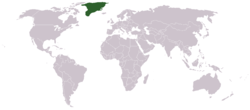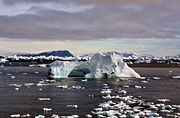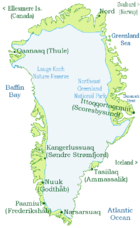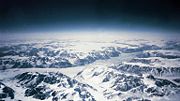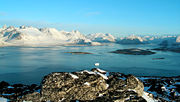Greenland
2008/9 Schools Wikipedia Selection. Related subjects: Americas; North American Geography
| Kalaallit Nunaat Grønland Greenland |
||||
|---|---|---|---|---|
|
||||
| Anthem: Nunarput utoqqarsuanngoravit |
||||
|
|
||||
| Capital (and largest city) |
Nuuk (Godthåb) |
|||
| Official languages | Kalaallisut , Danish | |||
| Demonym | Greenlandic | |||
| Government | Parliamentary democracy within a constitutional monarchy | |||
| - | Monarch | Margrethe II | ||
| - | Prime Minister | Hans Enoksen | ||
| Autonomous province of the Kingdom of Denmark | ||||
| - | Home rule | 1979 | ||
| Area | ||||
| - | Total | 2,166,086 km² ( 13th) 836,109 sq mi |
||
| - | Water (%) | 81.11 | ||
| Population | ||||
| - | July 2007 estimate | 56,344 | ||
| - | Density | 0.026/km² ( 241th) 0.067/sq mi |
||
| GDP ( PPP) | 2001 estimate | |||
| - | Total | $1.1 billion ( not ranked) | ||
| - | Per capita | $19,0002 ( not ranked) | ||
| HDI (n/a) | n/a (n/a) ( n/a) | |||
| Currency | Danish krone ( DKK) |
|||
| Time zone | ( UTC0 to -4) | |||
| Internet TLD | .gl | |||
| Calling code | +299 | |||
| 1 | As of 2000: 410,449 km² (158,433 sq. miles) ice-free; 1,755,637 km² (677,676 sq. miles) ice-covered. | |||
| 2 | 2001 estimate. | |||
Greenland ( Kalaallisut: Kalaallit Nunaat, meaning "Land of the Greenlanders"; Danish: Grønland) is a self-governing Danish province located between the Arctic and Atlantic Oceans, east of the Canadian Arctic Archipelago. Though physiographically and ethnically an Arctic island nation associated with the continent of North America, politically and historically Greenland is associated with Europe, specifically Iceland, Norway, and Denmark. In 1978, Denmark granted home rule to Greenland, making it an equal member of the Rigsfællesskab. Greenland is, by area, the world's largest island which is not a continent in its own right.
History
In prehistoric times, Greenland was home to a number of Paleo-Eskimo cultures. From AD 984 it was colonized by Norse settlers in two settlements on the west coast on the fjords near the very southwestern tip of the island. They thrived for a few centuries, but disappeared sometime in the 15th century.
Data from ice cores indicate that from AD 800 to 1300 the regions around the fjords of southern Greenland experienced a relatively mild climate, with temperatures similar to today. Trees and herbaceous plants grew there, and the climate initially allowed farming of livestock as in Norway. These remote communities thrived on farming, hunting and trade with Norway. When the Norwegian kings converted their domains to Christianity, a bishop was installed in Greenland, subordinate to the archdiocese of Nidaros. The settlements seem to have coexisted relatively peacefully with the Inuit, who had migrated south from the Arctic islands of North America around 1200. In 1261, Greenland became part of the Kingdom of Norway.
Around the 14th and 15th centuries, the Norwegian settlements vanished, likely due to famine and increasing conflicts with the Inuit. The condition of human bones from this period indicates the Norse population was malnourished. Main reasons appeared to have been soil erosion due to destruction of the natural vegetation for farming, turf, and wood by the Norse, a decline in temperatures during the Little Ice Age, and armed conflicts with the Inuit. Jared Diamond suggests that cultural practices, such as rejecting fish as a source of food and reliance solely on livestock ill-adapted to Greenland's climate, caused by the mini-ice age, which resulted in recurring famines, with environmental degradation led to the abandonment of the colony. However, other research has suggested that fish were a major source of food for the Norse Greenlanders from the early 1300s on.
The Kingdom of Denmark–Norway reasserted its latent claim to the colony in 1721. But ties with Norway were severed by the Treaty of Kiel of 1814, ceding Norway to the king of Sweden while Denmark retained the Norwegian overseas possessions: the Faroe Islands, Iceland and Greenland, as well as Denmark-Norway's small territories in India ( Tranquebar), West Africa ( Danish Gold Coast), and the West Indies ( Danish Virgin Islands).
Norway occupied and claimed parts of (then uninhabited) East Greenland also called Erik the Red's Land in July 1931, claiming that it constituted Terra nullius. Norway and Denmark agreed to settle the matter at the Permanent Court of International Justice in 1933, where Norway lost.
During World War II, Greenland's connection to Denmark was severed on April 9, 1940 when Denmark was occupied by Germany. Greenland was able to buy goods from the United States and Canada, by selling cryolite from the mine in Ivigtût. During the war the system of government changed. Governor Eske Brun ruled the island via a 1925 law that allowed governors to take control under extreme circumstances. The other governor, Aksel Svane, was transferred to the US to lead the commission to supply Greenland. The Sirius Patrol, guarding the northeastern shores of Greenland using dog sleds, detected and destroyed several German weather stations, giving Denmark a better position in the postwar turmoil.
Greenland had been a protected and very isolated society until 1940. The Danish government, which governed its colony Greenland, had been convinced that the society would face exploitation from the outside world or even extinction if the country was opened up. But during World War II, Greenland developed a sense of self-reliance through its self-government and independent communication with the outside world.
However, a commission in 1946 (with the highest Greenlandic council Landsrådet as participant) recommended patience and no radical reformation of the system. Two years later the first step towards changing the government was initiated when a grand commission was founded. In 1950 the report (G-50) was presented. Greenland was to be a modern welfare society with Denmark as the sponsor and example. In 1953, Greenland was made an equal part of the Danish Kingdom. Home rule was granted in 1979.
Etymology
The name Greenland comes from Scandinavian settlers. In the Icelandic sagas, it is said that Norwegian-born Erik the Red was exiled from Iceland for murder. He, along with his extended family and thralls, set out in ships to find the land that was rumoured to be to the northwest. After settling there, he named the land Grænland ("Greenland"). Greenland was also called Gruntland ("Ground-land") and Engronelant (or Engroneland) on early maps. Whether green is an erroneous transcription of grunt ("ground"), which refers to shallow bays, or vice versa, is not known. It should also be noted, however, that the southern portion of Greenland (not covered by glacier) is indeed very green in the summer and was likely to have been even greener in Erik's time because of the Medieval Warm Period.
Sovereignty
Norse Greenlanders submitted to Norwegian rule in the 13th century — and Norway entered in a personal union with Denmark in 1380 and from 1397 as a part of the Kalmar Union. From 1536, after Sweden had broken out of the union, Norway entered into a closer dependency of Denmark, i.e., kingdom of Denmark-Norway which existed until 1814. At that time, the kingdom of Denmark-Norway found itself on the losing side of the Napoleonic Wars. In gratitude to Sweden for her assistance in defeating Napoleon (and as a consolation for the recent loss of Finland to Russia), mainland Norway and certain Norwegian territories were transferred to Sweden — thus, the personal union of Norway and Denmark ended. The dependencies of Greenland, Iceland and the Faroe Islands, however, remained part of the reorganised "Kingdom of Denmark".
In the early 20th century, the United States was believed to have claims made good by discovery and exploration of the Peary expeditions.
In 1933, Norway attempted to claim eastern Greenland. The Permanent Court of Arbitration decided that the entire island belonged to Denmark.
During the Cold War, the United States developed a geopolitical interest in Greenland, and therefore in 1946, the United States offered to buy Greenland from Denmark for $100,000,000, but Denmark did not agree to sell.
Greenland became an integral part of the Kingdom of Denmark in 1953. It was granted home rule by the Folketing (Danish parliament) in 1978. The law went into effect on May 1, 1979. The Queen of Denmark, Margrethe II, remains Greenland's Head of State. Greenlandic voters subsequently chose to leave the European Economic Community upon achieving self-rule, because they did not want to allow European fishing fleets in Greenlandic waters.
A referendum on further self-rule is scheduled for 25 November 2008.
Politics
Greenland's Head of State is currently Margrethe II. The Queen's government in Denmark appoints a Rigsombudsmand ( High commissioner) representing the Danish government and monarchy.
Greenland has an elected parliament of thirty-one members. The head of government is the Prime Minister, who is usually the leader of the majority party in Parliament. The current Prime Minister is Hans Enoksen.
In 1985, Greenland left the European Community (EC), unlike Denmark which remains a member. The EC later became the EU (European Union) when it was renamed and expanded in scope in 1992. Greenland retains some ties with the EU via Denmark.
Geography and climate
The Atlantic Ocean borders Greenland's southeast; the Greenland Sea is to the east; the Arctic Ocean is to the north; and Baffin Bay is to the west. The nearest countries are Iceland, east of Greenland in the Atlantic Ocean, and Canada, to the west and across Baffin Bay. Greenland is the world's largest island, and is the largest dependent territory by area in the world. It also contains the world's largest national park.
The total area of Greenland measures 2,166,086 km² (836,109 sq mi), of which the Greenland ice sheet covers 1,755,637 km² (677,676 sq mi) (81%). The coastline of Greenland is 39,330 km (24,430 mi) long, about the same length as the Earth's circumference at the Equator. The highest point on Greenland is Gunnbjørn at 3,694 metres (12,119 ft).
The weight of the massive Greenlandic ice cap has depressed the central land area to form a basin lying more than 300 m (1,000 ft) below sea level. The ice flows generally to the coast from the centre of the island.
All towns and settlements of Greenland are situated along the ice-free coast, with the population being concentrated along the Western coast. The northeastern part of Greenland, which includes sections of North Greenland and East Greenland, is not part of any municipality, but is the site of the world's largest national park, Northeast Greenland National Park.
At least four scientific expedition stations and camps had been established in the ice-covered central part of Greenland (indicated as pale blue in the map to the right), on the ice sheet: Eismitte, North Ice, North GRIP Camp and The Raven Skiway. Currently, there is a year-round station, Summit Camp, on the ice sheet, established in 1989. The radio station Jørgen Brøndlund Fjord was, until 1950, the northernmost permanent outpost in the world.
The extreme north of Greenland, Peary Land, is not covered by an ice sheet, because the air there is too dry to produce snow, which is essential in the production and maintenance of an ice sheet. If the Greenland ice sheet were to completely melt away, sea level would rise by more than 7 m (23 ft) and Greenland would most likely become an archipelago.
Between 1989 and 1993, U.S. and European climate researchers drilled into the summit of Greenland's ice sheet, obtaining a pair of two mile (3 km) long ice cores. Analysis of the layering and chemical composition of the cores has provided a revolutionary new record of climate change in the Northern Hemisphere going back about 100,000 years and illustrated that the world's weather and temperature have often shifted rapidly from one seemingly stable state to another, with worldwide consequences. The glaciers of Greenland are also contributing to global sea level rise at a faster rate than was previously believed. Between 1991 and 2004, monitoring of the weather at one location (Swiss Camp) found that the average winter temperature had risen almost 6 ° C (approx. 10 ° F). Other research has shown that higher snowfalls from the North Atlantic oscillation caused the interior of the ice cap to thicken by an average of 6 cm/yr between 1994 and 2005.
However, a recent study suggests a much warmer planet in relatively recent geological times:
Scientists who probed two kilometers (1.2 miles) through a Greenland glacier to recover the oldest plant DNA on record said Thursday the planet was far warmer hundreds of thousands of years ago than is generally believed. DNA of trees, plants and insects including butterflies and spiders from beneath the southern Greenland glacier was estimated to date to 450,000 to 900,000 years ago, according to the remnants retrieved from this long-vanished boreal forest. That view contrasts sharply with the prevailing one that a lush forest of this kind could only have existed in Greenland as recently as 2.4 million years ago. The existence of those DNA samples suggest the temperature probably reached 10 degrees C (50 degrees Fahrenheit) in the summer and -17 °C (1 °F) in the winter. They also indicated that during the last interglacial period, 116,000–130,000 years ago, when temperatures were on average 5 °C (9 °F) higher than now, the glaciers on Greenland did not completely melt away.
In 1996, the American "Top of the World" expedition found the world's northernmost island off Greenland: ATOW1996. An even more northerly candidate was spotted during the return from the expedition, but its status is yet to be confirmed.
In 2007, the existence of a "new" island was announced. Named " Uunartoq Qeqertoq" (English: Warming Island), this island has always been present off the coast of Greenland, but was covered by an ice sheet. This ice sheet was discovered to be shrinking rapidly in 2002, and by 2007 had completely melted away, leaving the exposed island. This however was not the first occurrence of the island distinction. In Arctic Riviera, published by Ernst Hofer in 1957, in maps, and pictures, Ernst Hofer showed the distinct three fingered island separate from the mainland, during a similar warming event.
Topography
About 81 percent of Greenland's surface is covered by the Greenland ice sheet. The weight of the ice has depressed the central land area into a basin shape, whose base lies more than 300 metres (984 ft) below the surrounding ocean. Elevations rise suddenly and steeply near the coast. Approximately one-twentieth of the world's ice and one-quarter of the earth's surface ice is found in Greenland.
Economy
Greenland today is critically dependent on fishing and fish exports; the shrimp fishing industry is by far the largest income earner. Despite resumption of several interesting hydrocarbon and mineral exploration activities, it will take several years before hydrocarbonate production can materialize. The state oil company NUNAOIL was created in order to help develop the hydrocarbon industry in Greenland. The state company Nunamineral has been launched on the OMX20 Stock exhchange of Copenhagen to raise more capital to increase the newly started gold production. Exploitation of ruby deposits have also begun, even though production is still in its dawn. Numerous other mineral reserves are growing increasingly interesting as prices are increasing; these include uranium, aluminium, nickel, platinum, tungsten, titanium, and copper. Tourism is the only sector offering any near-term potential and even this is limited due to a short season and high costs. The public sector, including publicly owned enterprises and the municipalities, plays the dominant role in Greenland's economy. About half the government revenues come from grants from the Danish Government, an important supplement to the gross domestic product (GDP). Gross domestic product per capita is equivalent to that of the weaker economies of Europe.
Greenland suffered economic contraction the early 1990s, but since 1993 the economy has improved. The Greenland Home Rule Government (GHRG) has pursued a tight fiscal policy since the late 1980s which has helped create surpluses in the public budget and low inflation. Since 1990, Greenland has registered a foreign trade deficit following the closure of the last remaining lead and zinc mine that year.
Transport
The major airport is Kangerlussuaq Airport on the West coast at Kangerlussuaq. Intercontinental flights connect mainly to Copenhagen. As of May 2007, Air Greenland initiated a seasonal route to and from Baltimore in the United States. However, on March 10, 2008, the route was cancelled due to finanical losses. Also new for summer 2007, Air Iceland plans to fly between Keflavík and Nuuk three times a week. In addition to these routes there are scheduled international flights between Narsarsuaq and Copenhagen and between Kulusuk on the East coast to Reykjavík. Kangerlussuaq is the hub for domestic flights within Greenland.
Demographics
Greenland has a population of 56,344 (2007), of whom 88% are Inuit or mixed Danish and Inuit. The remaining 12% are of European extraction, mainly Danish. The majority of the population is Evangelical Lutheran. Nearly all Greenlanders live along the fjords in the south-west of the main island, which have a relatively mild climate.
Languages
The official languages of Greenland are Greenlandic (Kalaallisut) and Danish, and most of the population speak both of the languages. Greenlandic is spoken by about 50,000 people, some of whom are monolingual. A minority of Danish migrants with no Inuit ancestry speak Danish as their first, or only, language. English is widely spoken as a third language.
The Greenlandic language is the most populous of the languages of the Eskimo-Aleut language family and it has as many speakers as all the other languages of the family combined. Within Greenland, three main dialects are recognized: the northern dialect Inuktun or Avanersuarmiutut spoken by around 1000 people in the region of Qaanaaq, Western Greenlandic or Kalaallisut which serves as the official standard language, and the Eastern dialect Tunumiit oraasiat or Tunumiutut spoken in eastern Greenland.
Culture
The Greenland National Museum and Archives is located in Nuuk.
Sport
Association football is the national sport of Greenland, but Greenland is not a member of FIFA. In January 2007, Greenland took part in the World Men's Handball Championship in Germany, finishing 22nd in a field of 24 national teams.
Greenland competes in the bi-annual Island Games.

